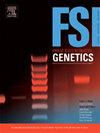Establishment and application of a triplex RTqPCR assay system for the identification of forensic body fluids
IF 3.1
2区 医学
Q2 GENETICS & HEREDITY
引用次数: 0
Abstract
MicroRNAs (miRNAs) have emerged as valuable biomarkers for the identification of forensic body fluids due to their stability and tissue specificity. However, the limited quantity of body fluid at crime scenes often hampers the accuracy of miRNA-based detection methods. In this study, we developed a triplex reverse transcription-quantitative polymerase chain reaction (RT-qPCR) assay system that enables the simultaneous detection of three miRNAs, improving throughput and efficiency while overcoming challenges in forensic investigations. First, the primers and probes of the miRNAs were redesigned to meet multiple detection requirements on the basis of a previous study in which five types of body fluid-specific miRNAs and internal genes (miR-451a, miR-891a-5p, miR-144–5p, miR-203a-3p, miR-223–3p and miR-320a-3p) were screened in a laboratory. The primer and probe concentrations, premix concentration and annealing temperature were subsequently optimized to establish a triplex RT![]() qPCR assay system. This system enables the simultaneous reverse transcription of six miRNAs from a single sample, followed by two separate triplex amplification reactions to quantitatively analyze all six miRNA markers. The amplification efficiency, primer cross-reactivity, repeatability, triplex detection and single detection results of the system were subsequently analysed, and a prediction model was constructed by combining the sample data with a kernel density estimation (KDE) method. Finally, the ability of the detection method to identify body fluids was further verified with authentic samples. The results demonstrate that the optimized triplex RT
qPCR assay system. This system enables the simultaneous reverse transcription of six miRNAs from a single sample, followed by two separate triplex amplification reactions to quantitatively analyze all six miRNA markers. The amplification efficiency, primer cross-reactivity, repeatability, triplex detection and single detection results of the system were subsequently analysed, and a prediction model was constructed by combining the sample data with a kernel density estimation (KDE) method. Finally, the ability of the detection method to identify body fluids was further verified with authentic samples. The results demonstrate that the optimized triplex RT![]() qPCR assay system achieves the same detection performance as the single detection system, but is faster and more cost-effective. This technology is especially suitable for the detection of trace body fluid stains left at crime scenes and effectively solves the contradiction between the requirements of repeated RT
qPCR assay system achieves the same detection performance as the single detection system, but is faster and more cost-effective. This technology is especially suitable for the detection of trace body fluid stains left at crime scenes and effectively solves the contradiction between the requirements of repeated RT![]() qPCR detection of traces and multiple sample sizes. In addition, the body fluid identification model, which was established by the data obtained from the triplex RT
qPCR detection of traces and multiple sample sizes. In addition, the body fluid identification model, which was established by the data obtained from the triplex RT![]() qPCR system combined with KDE, was successfully applied to predict and identify simulated samples and actual samples. This system provides an effective tool for the identification of suspicious body fluids and lays the foundation for further research on multiplex RT
qPCR system combined with KDE, was successfully applied to predict and identify simulated samples and actual samples. This system provides an effective tool for the identification of suspicious body fluids and lays the foundation for further research on multiplex RT![]() qPCR assay systems and the construction of more accurate data models.
qPCR assay systems and the construction of more accurate data models.
法医体液鉴定三重RTqPCR检测系统的建立与应用
由于其稳定性和组织特异性,MicroRNAs (miRNAs)已成为鉴定法医体液的有价值的生物标志物。然而,犯罪现场的体液数量有限,往往会影响基于mirna的检测方法的准确性。在这项研究中,我们开发了一种三重逆转录-定量聚合酶链反应(RT-qPCR)检测系统,可以同时检测三种mirna,提高了通量和效率,同时克服了法医调查中的挑战。首先,在先前实验室筛选五种体液特异性mirna及其内部基因(miR-451a、miR-891a-5p、miR-144-5p、miR-203a-3p、miR-223-3p和miR-320a-3p)的基础上,重新设计mirna的引物和探针,以满足多种检测需求。随后对引物和探针浓度、预混料浓度和退火温度进行优化,建立了三重RTqPCR检测体系。该系统能够同时对来自单个样品的六个miRNA进行逆转录,然后进行两个单独的三重扩增反应,以定量分析所有六个miRNA标记物。随后对该体系的扩增效率、引物交叉反应性、重复性、三检和单检结果进行分析,并结合样本数据和核密度估计(KDE)方法构建预测模型。最后,用真实样本进一步验证了该检测方法对体液的识别能力。结果表明,优化后的三联RTqPCR检测系统与单联检测系统的检测性能相同,但速度更快,成本更低。该技术特别适用于犯罪现场遗留的微量体液污渍的检测,有效解决了RTqPCR重复检测痕迹的要求与多样本量之间的矛盾。此外,将三重RTqPCR系统获得的数据与KDE相结合建立的体液鉴定模型成功地应用于模拟样品和实际样品的预测和鉴定。该系统为可疑体液的鉴定提供了有效的工具,为进一步研究多重RTqPCR检测系统和构建更准确的数据模型奠定了基础。
本文章由计算机程序翻译,如有差异,请以英文原文为准。
求助全文
约1分钟内获得全文
求助全文
来源期刊
CiteScore
7.50
自引率
32.30%
发文量
132
审稿时长
11.3 weeks
期刊介绍:
Forensic Science International: Genetics is the premier journal in the field of Forensic Genetics. This branch of Forensic Science can be defined as the application of genetics to human and non-human material (in the sense of a science with the purpose of studying inherited characteristics for the analysis of inter- and intra-specific variations in populations) for the resolution of legal conflicts.
The scope of the journal includes:
Forensic applications of human polymorphism.
Testing of paternity and other family relationships, immigration cases, typing of biological stains and tissues from criminal casework, identification of human remains by DNA testing methodologies.
Description of human polymorphisms of forensic interest, with special interest in DNA polymorphisms.
Autosomal DNA polymorphisms, mini- and microsatellites (or short tandem repeats, STRs), single nucleotide polymorphisms (SNPs), X and Y chromosome polymorphisms, mtDNA polymorphisms, and any other type of DNA variation with potential forensic applications.
Non-human DNA polymorphisms for crime scene investigation.
Population genetics of human polymorphisms of forensic interest.
Population data, especially from DNA polymorphisms of interest for the solution of forensic problems.
DNA typing methodologies and strategies.
Biostatistical methods in forensic genetics.
Evaluation of DNA evidence in forensic problems (such as paternity or immigration cases, criminal casework, identification), classical and new statistical approaches.
Standards in forensic genetics.
Recommendations of regulatory bodies concerning methods, markers, interpretation or strategies or proposals for procedural or technical standards.
Quality control.
Quality control and quality assurance strategies, proficiency testing for DNA typing methodologies.
Criminal DNA databases.
Technical, legal and statistical issues.
General ethical and legal issues related to forensic genetics.

 求助内容:
求助内容: 应助结果提醒方式:
应助结果提醒方式:


